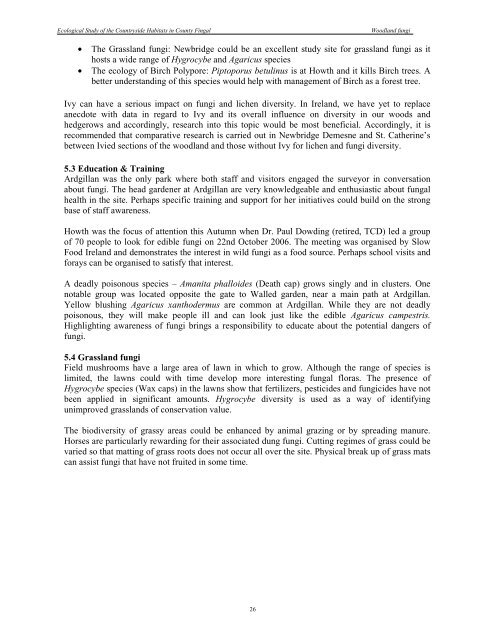2006 Fungi of Fingal Woodlands - Fingal Biodiversity
2006 Fungi of Fingal Woodlands - Fingal Biodiversity
2006 Fungi of Fingal Woodlands - Fingal Biodiversity
Create successful ePaper yourself
Turn your PDF publications into a flip-book with our unique Google optimized e-Paper software.
Ecological Study <strong>of</strong> the Countryside Habitats in County <strong>Fingal</strong> Woodland fungi<br />
• The Grassland fungi: Newbridge could be an excellent study site for grassland fungi as it<br />
hosts a wide range <strong>of</strong> Hygrocybe and Agaricus species<br />
• The ecology <strong>of</strong> Birch Polypore: Piptoporus betulinus is at Howth and it kills Birch trees. A<br />
better understanding <strong>of</strong> this species would help with management <strong>of</strong> Birch as a forest tree.<br />
Ivy can have a serious impact on fungi and lichen diversity. In Ireland, we have yet to replace<br />
anecdote with data in regard to Ivy and its overall influence on diversity in our woods and<br />
hedgerows and accordingly, research into this topic would be most beneficial. Accordingly, it is<br />
recommended that comparative research is carried out in Newbridge Demesne and St. Catherine’s<br />
between Ivied sections <strong>of</strong> the woodland and those without Ivy for lichen and fungi diversity.<br />
5.3 Education & Training<br />
Ardgillan was the only park where both staff and visitors engaged the surveyor in conversation<br />
about fungi. The head gardener at Ardgillan are very knowledgeable and enthusiastic about fungal<br />
health in the site. Perhaps specific training and support for her initiatives could build on the strong<br />
base <strong>of</strong> staff awareness.<br />
Howth was the focus <strong>of</strong> attention this Autumn when Dr. Paul Dowding (retired, TCD) led a group<br />
<strong>of</strong> 70 people to look for edible fungi on 22nd October <strong>2006</strong>. The meeting was organised by Slow<br />
Food Ireland and demonstrates the interest in wild fungi as a food source. Perhaps school visits and<br />
forays can be organised to satisfy that interest.<br />
A deadly poisonous species – Amanita phalloides (Death cap) grows singly and in clusters. One<br />
notable group was located opposite the gate to Walled garden, near a main path at Ardgillan.<br />
Yellow blushing Agaricus xanthodermus are common at Ardgillan. While they are not deadly<br />
poisonous, they will make people ill and can look just like the edible Agaricus campestris.<br />
Highlighting awareness <strong>of</strong> fungi brings a responsibility to educate about the potential dangers <strong>of</strong><br />
fungi.<br />
5.4 Grassland fungi<br />
Field mushrooms have a large area <strong>of</strong> lawn in which to grow. Although the range <strong>of</strong> species is<br />
limited, the lawns could with time develop more interesting fungal floras. The presence <strong>of</strong><br />
Hygrocybe species (Wax caps) in the lawns show that fertilizers, pesticides and fungicides have not<br />
been applied in significant amounts. Hygrocybe diversity is used as a way <strong>of</strong> identifying<br />
unimproved grasslands <strong>of</strong> conservation value.<br />
The biodiversity <strong>of</strong> grassy areas could be enhanced by animal grazing or by spreading manure.<br />
Horses are particularly rewarding for their associated dung fungi. Cutting regimes <strong>of</strong> grass could be<br />
varied so that matting <strong>of</strong> grass roots does not occur all over the site. Physical break up <strong>of</strong> grass mats<br />
can assist fungi that have not fruited in some time.<br />
26


